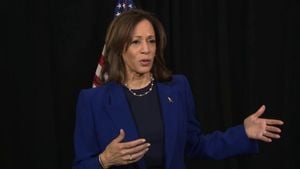The final sprint of the 2024 presidential race is upon us, and the contrasting closing arguments from Vice President Kamala Harris and former President Donald Trump couldn't be starker as they seek to sway undecided voters just days before the election.
At the heart of this election, Harris has been positioning herself not as just another candidate, but as the hopeful voice guiding Americans toward progress. At her recent rally at the Ellipse, she captivated nearly 75,000 supporters, where she outlined her vision for the future, labeling Trump as, among other things, a “petty tyrant.” This was her last major rally before the polls close, and her campaign emphasized the importance of this moment to clarify her message about protecting democracy.
On the same front, Trump held his own rally just days prior at Madison Square Garden, where prominent speakers like X CEO Elon Musk and Republican presidential candidate JD Vance backed him, showcasing his allegiance among certain factions of the Republican Party. Meanwhile, critics described his event as descending toward the level of chaotic spectacles reminiscent of past controversies.
Harris' efforts come after weeks of asserting Trump’s policies could irreversibly harm vulnerable communities, emphasizing her commitment to reproductive rights, health care accessibility, and economic equity. Across eight campaign events this past month, including three speeches in Michigan and a get-out-the-vote event with pop star Lizzo, the Vice President worked diligently to project optimism amid what she describes as Trump’s divisive, backward-looking rhetoric.
Reflecting on her campaign’s goals, Harris said, “America, for too long, we have been consumed with too much division, chaos, and mutual distrust. It is time for leadership characterized by unity and hope.” This marked her continued push against Trump’s reminder of dark days, with her campaign stating it’s about moving forward rather than rehearsing old grievances.
Critics from the left have hailed Harris’ rally as powerful and symbolic, framing it as a necessary counter to Trump’s philosophies. Conversely, some right-leaning outlets described her message as lacking fresh arguments. Harris, who has faced scrutiny for performance under pressure, aims to soothe skeptics with a cohesive strategy focused on common good.
The backdrop of their contrasting campaigns is the growing anticipation surrounding early ballots, which have already started flooding election offices across many states. While Harris is gaining traction, Trump's remarks continue to provoke strong reactions. During his speeches, he has doubled down on incendiary language and has utilized past grievances to rally his base. He described political rivals and dissenting voices as part of the “enemy from within,” reflecting fears of disunity and fracture among the populace.
Not one to let the moment pass by without showcasing his theatrical approach, Trump gave his followers what they expected—a return to familiar complaints and nostalgia for what he deems earlier American greatness. But some speculate whether this will resonate with voters tired of the cyclical nature of his messaging. Times are changing, and the current political climate demands fresh ideas.
Recent data suggests Harris finds herself benefiting from strong support among young Americans, minorities, and women, demographics he often overlooks or deliberately targets with his incendiary rhetoric. The latest polling indicates she's connecting significantly with young voters, drawing comparisons to how her contemporaries supported Biden previously.
Harris has also emphasized economic themes, focusing her messaging on job creation and supporting working families, often lamenting about the lost manufacturing jobs during Trump’s presidency. She stated, “Donald Trump has been one of the biggest losers of manufacturing jobs. While he made big promises, we saw tens of thousands of jobs vanish under his watch.” Critics quickly pointed out the pandemic's substantial impact on job loss, complicate the narrative she champions on the campaign trail.
By spotlighting concerns over reproductive rights, Harris reminded her audience of the perils many women now face after the recent Supreme Court decision overturning federal protections. Her campaign has invested heavily to raise awareness about reproductive issues within states where such rights are at risk.
Even amid this tight race, Harris has wasted no time poising herself as the candidate who champions progressive ideals, positioning herself against Trump’s far-right demonstrations of politics. Meanwhile, Trump has not shied away from courting divisive sentiments but finds himself facing mounting challenges appealing to broader demographics as many question his promise of unity.
The presence of moderates and disenchanted Republicans supporting Harris is another narrative gaining interest. Notably, former Republican Representative Liz Cheney has been vocal about her disdain for Trump's alarming trends, serving alongside Harris at campaign events. More than 100 Republican officials even put their names to public letters supporting her, illustrating the cracks forming within the GOP.
Harris’ ability to articulate and rally support for issues often overlooked by Trump’s followers gives her campaign strength. This includes her focus on environmental justice and efforts to protect immigrants—policy perspectives Trump continues to demonize.
But the race remains razor-thin. Both camps know stakes are high. Analysts suggest the election could swing on turnout; those most dedicated to voting will likely determine the outcome. Harris is in the midst of invigorated grassroots efforts, mobilizing supporters and encouraging early participation. Virginia's recent decision allowing nearly 1,000 voters to remain on the rolls has added layers of intrigue about how turnout could sway the election.
The tension present at rallies, the charged atmosphere, and palpable anticipation poised them against each other deeply highlight contrasting paths for America. Harris frames her closing arguments around restoring democratic ideals, focusing on hope and inclusivity. On the other hand, Trump’s approach plays to fear, capitalizing on resentment and misplaced blame as he offers disenchanted voters scripted grievances.
With just days remaining until Election Day on November 5, the race is set for nail-biting drama. News pundits, voters, and everyone invested will find themselves eagerly watching and waiting for the next chapter to be written. Each candidate is fully aware of their audience's demands and the stakes on the horizon. The very notion of democracy may hinge on which vision resonates more deeply with Americans still trying to navigate who they trust to lead them forward.



